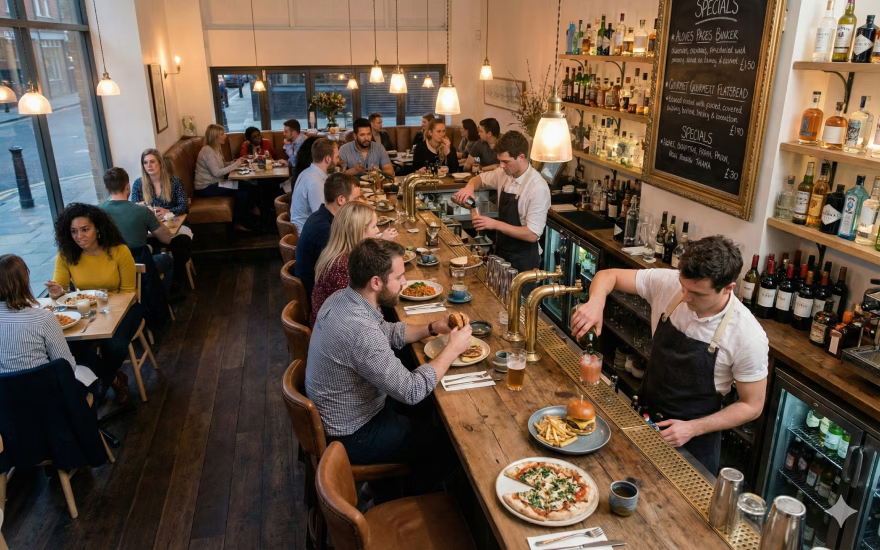The Economics of Gratitude: Taking a Closer Look into Tipping Culture

It seems that every time you step outside and purchase something, a screen swivels in your direction and asks, “Would you like to leave a tip?”
And, if you’re anything like most people, you panic.
You think to yourself, “I’m supposed to tip for self-serve frozen yogurt? Is that a thing now?”
So you look at the options and select the smallest one, which happens to be 18%.
For an overpriced yogurt that you made yourself.
Have you ever wondered how it came to be this way? Where did this whole idea of tipping food workers come from? Why can’t the price just be the price?
This article is going to explore just that: from tipping’s surprising origins to the latest trends shaping how we reward our dining experiences.
What Is Tipping?
Tipping refers to a discretionary payment left by a customer for service received, most commonly in the restaurant industry. It's a way to show appreciation and supplement a server's wages.

The Uncomfortable History and Evolution of Tipping Culture
Modern-day tipping in restaurants – whether fast casual or sit-down – can be a confusing dance of etiquette and financial responsibility.
Believe it or not, it wasn’t always this way.
Tipping has its roots in medieval Europe, when it was customary for masters to give servants a small reward for exceptional service. Upon a trip to Europe in the 18th century, some wealthy Americans picked up on the trend. (Some might consider this a bit ironic since most modern-day Europeans don’t tip when they eat out at restaurants). Wanting to seem aristocratic and worldly, though, some Americans brought tipping back to the United States.
And most people hated it.
In fact, tipping was considered deeply un-American during the first two centuries of US history and for most of the 19th century. However, it gained traction in the US after the Civil War, when newly freed slaves relied on tips to compensate for low (or no) wages.
Today, tipping is deeply ingrained in the restaurant industry, influencing everything from server income to menu pricing.
What Does the Public Think of Tipping?
Tipping has definitely been under fire as of late.
A survey done in June 2023 from Bankrate showed that 66% of Americans have a negative view of tipping.
- 41% of Americans said that they believed businesses should pay their employees better, so they wouldn’t have to rely on tips.
- 32% are annoyed at pre-entered tip screens (us too).
- 15% are confused about who and how much to tip. And if that’s you, scroll down to our guide below.
By and large, though, the public believes that if you’re at a sit-down restaurant in the US and you can’t afford at least a 15% tip, you can’t afford the meal. According to research from Pew Research Center, about nine in ten adults who eat at sit-down restaurants (92%) say they always or often leave a tip.
On the flip side, referencing that same data from Pew Research Center, almost everyone agrees that you don’t have to tip at cafes, self-service, fast food, or fast-casual restaurants – so why is everyone still being asked to tip every time that they buy something?
It’s simple: because it works. The guilt of not tipping drives many people to tip. As one consumer aptly put it:
“It makes you feel bad. You feel like you have to do it because they’re asking you to do it, but then you have to think about the position that puts people in. They’re paying for something that they really don’t want to pay for, or they’re tipping when they really don’t want to tip – or can’t afford to tip – because they don’t want to feel bad.”
The overwhelming public sentiment is that tipping culture has become somewhat out of control, especially in fast-casual settings.
But that begs the next question: if people are tipping just to avoid feeling bad, how much should you tip?

How Much to Tip in the Restaurant Industry?
Tipping etiquette varies depending on the service level and type of restaurant. As we noted above, virtually everyone who goes to a sit-down restaurant expects to tip – but what about all the other options?
Here's a quick overview:
- Full Service: Servers at sit-down restaurants traditionally expect 15-20% of the bill. If service was really good, 20-25% isn’t unheard-of either.
- Fast Casual: Tipping is less formal in fast-casual settings. 0-10% is customary, but some establishments don't expect tips at all. This largely depends on the level of service provided.
- Fast Food: Tipping is generally not expected at fast food restaurants where minimal service is provided.
- Bars: Bartenders usually receive 15-20% of the tab, or $1 per drink.
- Cafes: Similar to fast casual, tipping at cafes varies. Some have tip jars, while others don't expect a gratuity.
Hopefully that gives you some sort of idea so you can plan accordingly the next time that you’re out.
Tipping Trends in the Restaurant Industry
Technology plays a big role in tipping these days. Digital payment options have made it easier to leave a tip, while the demise of the physical tip jar has sparked debate.
Additionally, "tipflation" is on the rise, where rising menu prices lead to higher expected tip amounts. This has some consumers questioning the fairness of the system.
As an alternative, some restaurants are implementing mandatory service charges, sparking debates about transparency and server income. It’s also leading some consumers to “double-tip,” if they don’t notice that the service charge was already included. For many, the price is a small part of the issue. The lack of transparency regarding pricing, etiquette, and responsibility is a much bigger piece of the pie – and we’ll have to wait and see how that plays out in the future.
The Ongoing Debate: To Tip or Not to Tip?
Tipping is a double-edged sword. Here's a closer look at both sides:
Reasons for Tipping:
- Tipping directly incentivizes servers to provide attentive and friendly service.
- Tips supplement often low hourly wages, helping servers make a living wage.
Problems With Tipping:
- Servers rely heavily on tips, creating an unstable income. This can be stressful and disadvantageous.
- Tipping can be unpredictable, leading to income disparity among servers.
- There can be pressure to tip, even when the service is bad, leading to an unexpected moral dilemma.
- Menu prices don't reflect the full cost of service, potentially hindering budgeting for diners.

Potential Alternatives
Alternatives to tipping are on the horizon.
Some restaurants are experimenting with higher hourly wages and standardized service charges. These models aim to create a more transparent and predictable wage system for both servers and diners. Others have started using robots as servers, which naturally causes people to tip a bit less (if at all).
The Future of Tipping in the Restaurant Industry
The future of tipping is uncertain. However, one thing's for sure: technology, social norms, and consumer preferences will continue to shape how we reward service in restaurants.
Want to learn more about streamlining your restaurant operations? Simplify your workday with Push. Book a demo with us today!



